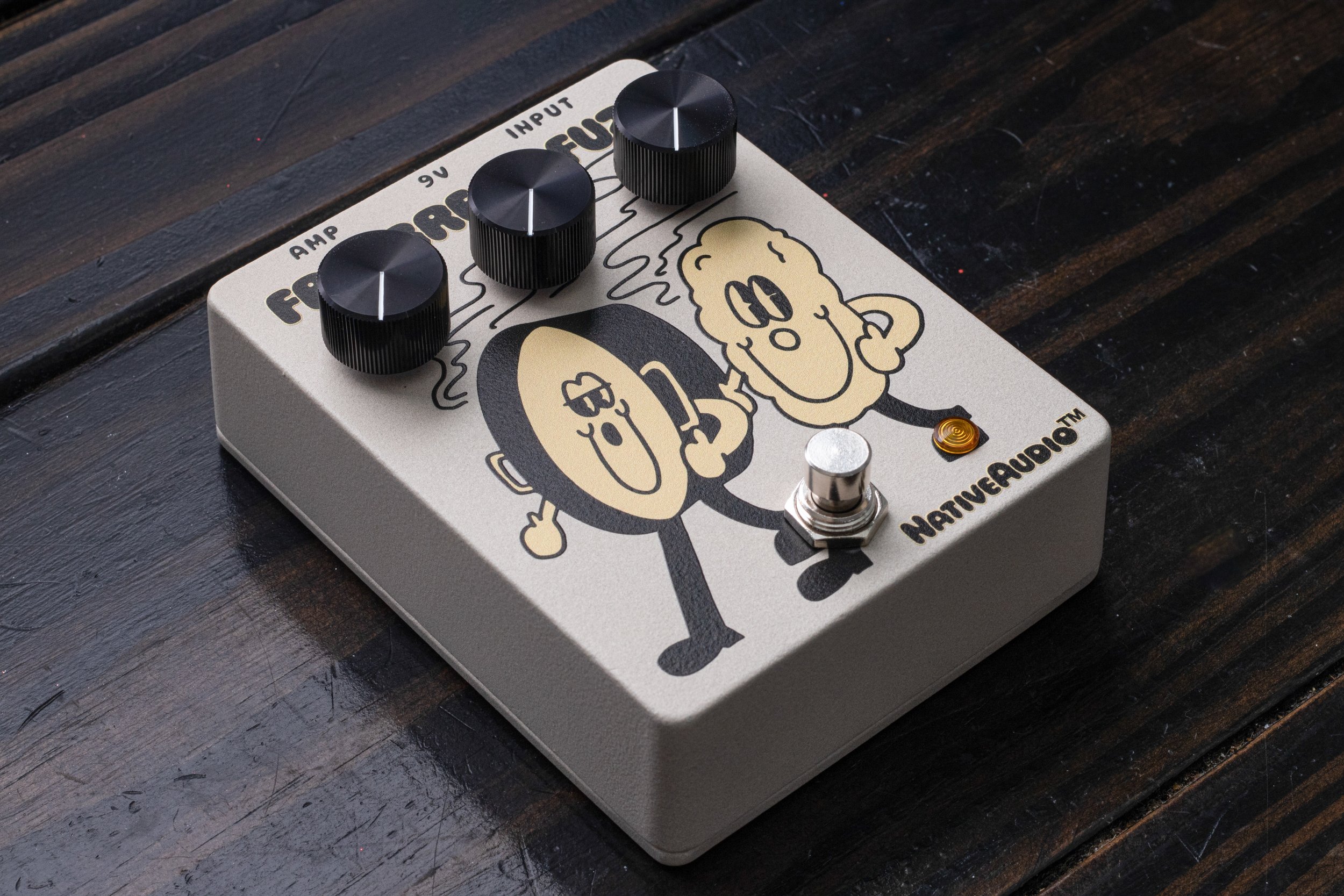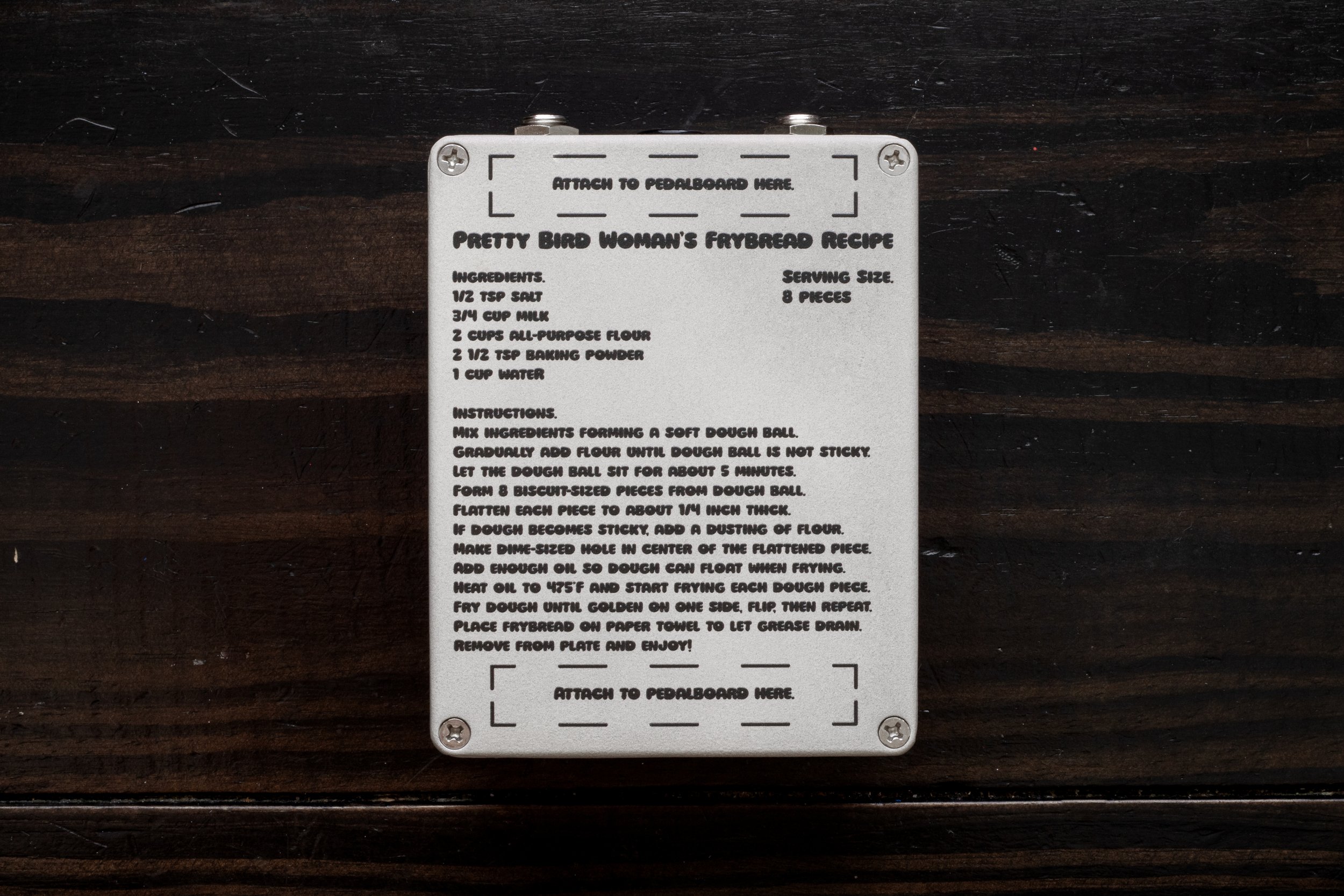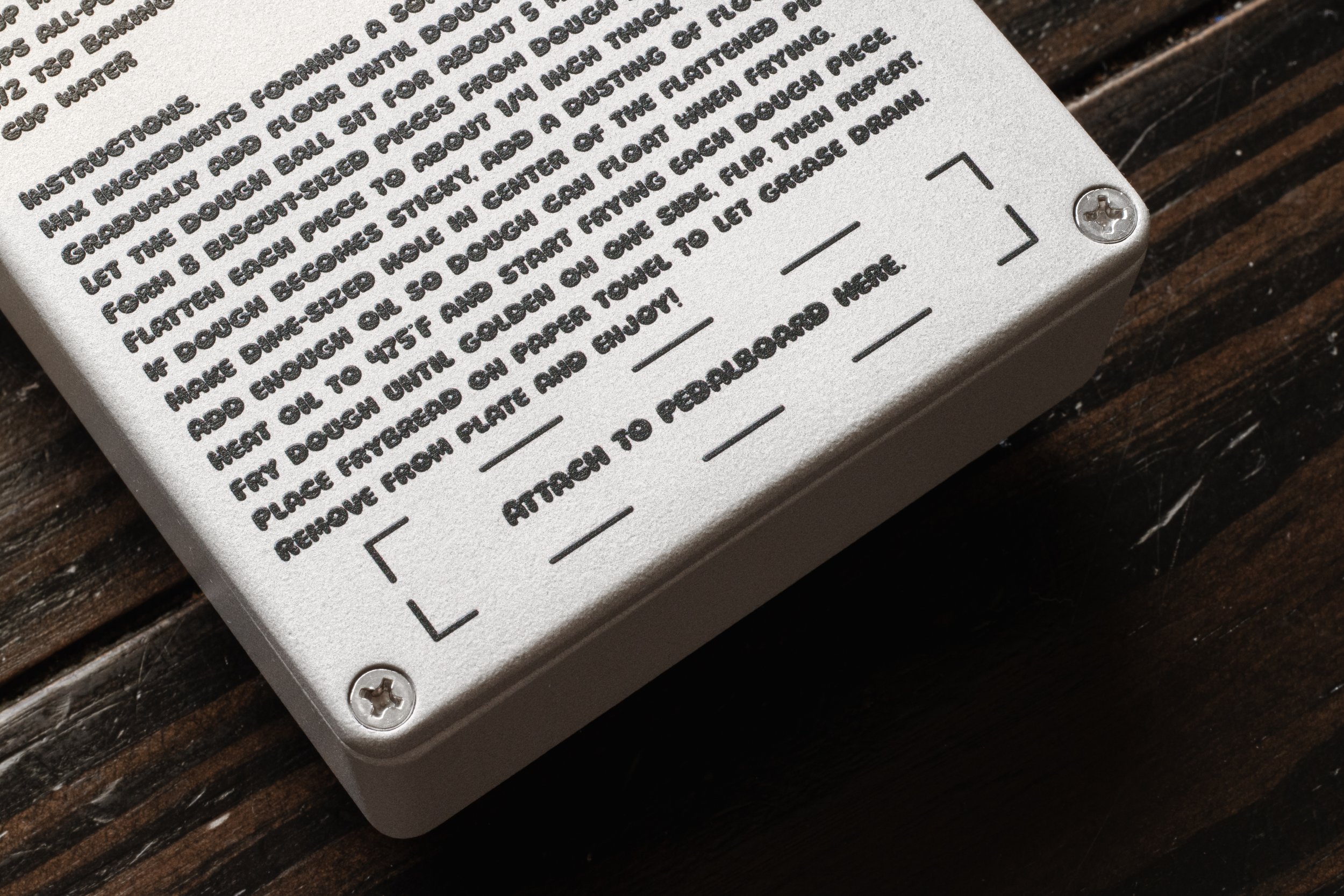Frybread Fuzz.
Fuzz. We finally did it.
We can’t believe it either, but we finally did it. It’s been eight long and fuzz-less years, but here we are. Why did it take so long? Honestly, I wanted to perfect the recipe and create a fuzz that would always sound great, regardless of its place in the chain or the day it was produced. I’ll get more into the nerdy stuff later, but for now, let’s dive in!
TLDR.
Who’s it for?
The Frybread Fuzz is designed for musicians seeking a no-fuss, comprehensive fuzz solution that stands out in the mix and sounds great regardless of its position in the signal chain.
What’s it for?
Frybread Fuzz is a transistor-based fuzz meticulously tuned to deliver a mid-focused character ranging from power-amp punch to blistering fuzz.
Frybread – A tribute to a Native delicacy.
Frybread Fuzz is a tribute to my Blackfeet (Amskaapi Piikuni) heritage and a tasteful dive into a traditional Native American bread. Frybread is versatile bread made with a simple set of ingredients that can be enjoyed with honey, jelly, or as an Indian Taco by topping with chili and your favorite taco toppings. The Frybread Fuzz artwork features the dynamic duo, Stan the Pan and Frybread Man.
Each Frybread Fuzz includes Pretty Bird Woman’s frybread recipe printed on the back of the pedal, ensuring that you’ll always have great tone and great food wherever you go. And remember, nothing cooks better than grandma’s recipe, so you’ll definitely enjoy this one!
The Frybread Fuzz sound.
We wanted to create a transistor-based fuzz that would stand out in the mix, offer plenty of versatility, and always sound amazing regardless of its position in the signal chain. What we ended up with is exactly that and more! During the development of the Frybread Fuzz, we stumbled upon a fun fuzz tone. It has this massive, power-amp pushed sound at all levels of fuzz. On the low gain side, it’s robust and rides the edge of breakup. As you crank up the gain, you begin to experience a large, punchy, and crunchy distortion reminiscent of cool Zeppelin vibes. Finally, with the fuzz control maxed out, you get this blistering fuzz with a gated and sub-harmonic voicing that offers a sustaining and chaotic fuzz sound. Oooooof. It's so good.
Over-engineered for your pleasure.
We've gone all out to ensure that the Frybread Fuzz delivers low noise, a wide range of sounds, and unmatched versatility for all setups. One of our major concerns with fuzz pedals is that many of them seem to be one-trick ponies, only working well with a specific rig. This is disappointing because everyone deserves a fuzz pedal that consistently sounds great. Here’s a list of what we’ve got cooking under the hood:
Multi-buffering stages for input and output signal conditioning.
Pickup simulation for a sickkkkk fuzz tone regardless of signal chain order.
Four-layer PCB design to reduce noise and provide a satisfying fuzz experience.
Each fuzz has been independently tuned to maximize fuzz character and response.
Dual-purpose volume/filter control to maintain optimum tonality across all volume levels.
Dual-purpose fuzz/filter control to adjust both gain and frequency in parallel to capture the ideal fuzz character.
Bread control slices high-frequency content to dial in the perfect amount of bite.
Smart switching enabling both latch and momentary switching.
We’ll take a pass on true bypass.
What’s the pros of our buffered bypass? Our buffered bypass won't mess with the highs or lows of your original signal, and it definitely won't give it an unnecessary boost. But here's the real bonus: when you're dealing with a bunch of patch cables or running long instrument cables, the signal stays true to its original sound. So, whether you're jamming with a tangled mess of cables or rocking out on a stage with some serious distance between you and your amp, rest assured that your sound will always stay pure and unaltered with our buffered-bypass design.
Put the fuzz before or after? That is the question.
Dude, that fuzz has to be first in the chain." It's a lie we've all been sold. We're all about breaking rules here at NativeAudio, which is why we wanted to create a pedal that sounds exactly the same regardless of its position in the signal chain. We cooked up a cool pickup simulator that we've integrated into the design. I know what you're thinking, "that sounds super digital, dude." Don’t worry, it’s a 100% analog solution that utilizes the same technology found in your pickup and integrates it right near the transistor-based fuzz circuit. This ensures that the fuzz circuit will always see the same impedance, whether the Frybread Fuzz is at the beginning, middle, or end of the signal chain.
Four is the magic number.
Typically, an effect pedal will use a two-layer printed circuit board (PCB) design, which consists of two copper layers on the outside and is separated by a dielectric or non-conducting material in the middle. The two-layer setup is solid for most applications.
However, issues arise when the circuit board becomes crowded with a ton of signals and components, especially for pedals designed to amplify signals like the fuzz. This is where the four-layer board design becomes advantageous. Although it may seem like overkill, using four layers instead of two provides better handling of noise and signals. Problems such as electromagnetic interference (EMI), electromagnetic compatibility (EMC), and ground issues are significantly reduced due to the additional options offered by the four-layer board design.
So for a pedal intended to amplify the instrument’s signal, this four-layer design ensures that it performs as intended, resulting in a more enjoyable and low-noise fuzz experience.
You can tune a fuzz like you tune a guitar.
Remember how I mentioned that we waited so long for a fuzz because I wanted to perfect the recipe? Well, one of my biggest goals was to ensure that each production unit sounded exactly as intended, regardless of temperature or the batch of transistors used that day during assembly. Thankfully, after hours of testing and perfecting the design, we developed a fuzz circuit that could be tuned to sound precisely like the unit built before and after it! This meant that Jill's Frybread Fuzz from Montana would sound exactly like Don's from Mississippi. This further supports our concept of creating a fuzz pedal that is reliable, regardless of its placement in the signal chain or the timing of its production.
Did someone say clarity?
The fry control on the Frybread Fuzz adjusts volume in a whole new way. Acting more as a dual-parameter control, fry adjusts your pedal’s volume while also tweaking a high-pass filter. This ensures that your tone doesn’t get muffled in a weird way and that the Frybread Fuzz always delivers the perfect amount of volume and clarity for your instrument’s signal.
Great tone at all levels of fuzz.
I’ve always struggled with various fuzz pedals that I’ve played. When the fuzz is cranked up, it sounds perfect! It’s the exact tone that the doctor ordered. Now, contrast that with when the fuzz is turned down (even just a little bit), and it's muffled, gross, and sounds like someone threw a blanket on your fun. We didn’t believe fuzz should be experienced this way.
We needed a fuzz that was flexible, could clean up well, and caused the right amount of tonal chaos when needed. Our solution was to have the fuzz control, like the fry (volume) control, do more than your typical stuff. When adjusted, the fuzz control actually determines the amount of signal sent into the fuzz circuit while also shaping how the signal clips. The result is a very responsive fuzz control with a smooth gain sweep that sounds great at all levels of fuzz, not just at the maxed-out setting.
Slice the bad tone out of your life.
In addition to the mid-focused character of the Frybread Fuzz, the bread control helps slice high-frequency content to dial in the perfect amount of bite. The control acts as a high-cut filter and has been adjusted to provide a solid range of tone control. So, no matter where you are on the gain, you always have enough highs and lows to cut through the mix.
Switching made fun.
Each NativeAudio pedal utilizes smart switching. How does smart switching work? Our pedals can tell how long you hold the switch, then determine which mode to use. Latch mode is your traditional switching method where you press the switch quickly and the pedal turns on. Momentary, on the other hand, works by holding the switch down, playing your riff, then releasing when you’re ready to turn the pedal off. Either switching method will get the job done but it’s all about giving you the flexibility to shape your sound.
A big thank you.
We love what we do here at NativeAudio, and we couldn’t do it without your love and support. Our aim is to share culture in a cool and exciting way, and I believe Frybread Fuzz truly embodies this by offering a fun way to dive into the culture of Native cuisine while also delivering a flexible and consistently great-sounding fuzz. We hope you enjoy it and can’t wait to see the creativity this fuzz inspires!
Much love.
-Mike Trombley, Founder









